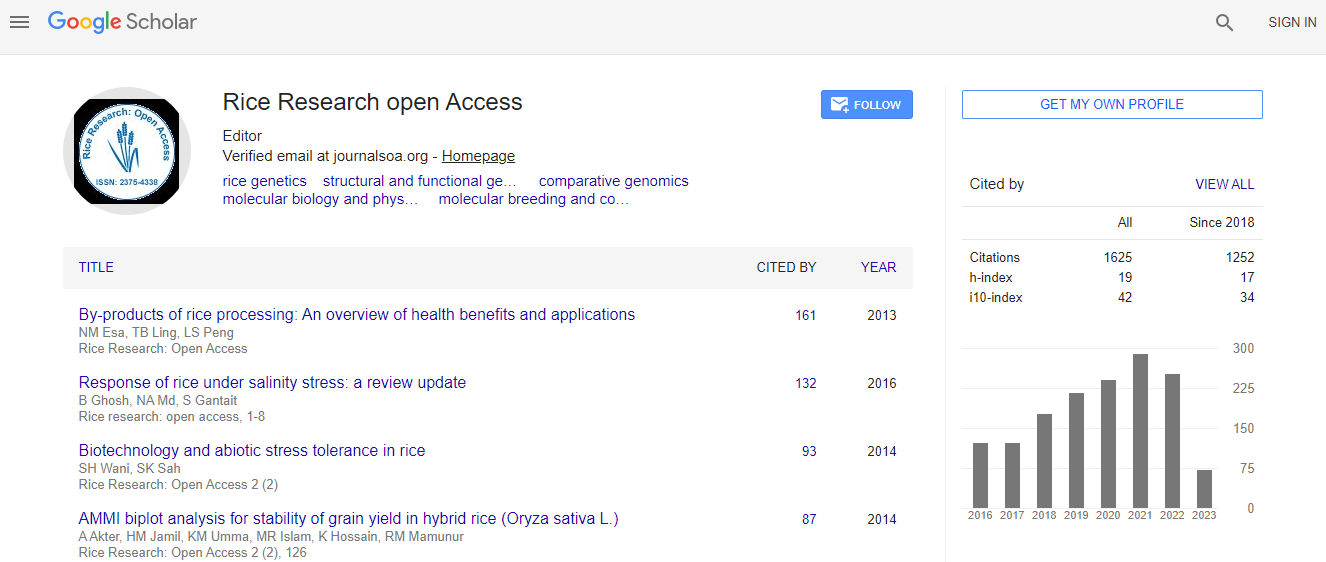Review Article
Weedy Rice: An Emerging Threat for Direct-seeded Rice Production Systems in India
| Kanwar Singh1,Virender Kumar2, Yashpal S Saharawat3,Mahesh Gathala4, JK Ladha1,and Bhagirath S Chauhan5* | ||
| 1International Rice Research Institute - India office, New Delhi, India | ||
| 2CIMMYT, Patna, India | ||
| 3IARI, New Delhi, India | ||
| 4CIMMYT, Dhaka, Bangladesh | ||
| 5International Rice Research Institute, Los Baños, Philippines | ||
| Corresponding Author : | Bhagirath Singh Chauhan International Rice Research Institute Philippines E-mail: b.chauhan@irri.org |
|
| Received July 11, 2013; Accepted August 16, 2013; Published August 21, 2013 | ||
| Citation: Chauhan BS, Singh K, Ladha JK, Kumar V, Saharawat YS, et al. (2013) Weedy Rice: An Emerging Threat for Direct-seeded Rice Production Systems in India. J Rice Res 1:106. doi: 10.4172/jrr.1000106 | ||
| Copyright: © 2013 Chauhan BS, et al. This is an open-access article distributedunder the terms of the Creative Commons Attribution License, which permits unrestricted use, distribution, and reproduction in any medium, provided the original author and source are credited. | ||
Related article at Pubmed Pubmed  Scholar Google Scholar Google |
||
Abstract
Rice is an important cereal crop in India for food security. Conventional practices for rice production (puddled transplanting) are labour-, water-, and energy-intensive. All of these resources are becoming increasingly scarce and expensive, thus making puddled transplanting less profitable. Moreover, this practice deteriorates soil physical properties and causes adverse effects on the productivity of succeeding upland crops. All these factors are forcing farmers to shift from puddled transplanted to direct-seeded rice (DSR) in irrigated or favourable rainfed rice-growing areas. Weedy rice, however, has emerged as a serious threat to rice production in countries (Malaysia, Sri Lanka, Thailand, Vietnam, the Philippines, and the United States) where DSR systems are common. Based on experiences in these countries, it is predicted that weedy rice is likely to emerge as a major threat in DSR production systems in India. Weedy rice is highly competitive and difficult to control in rice and can result in complete crop loss if not contained. Therefore, there is a need to develop ecologically based integrated management strategies in advance to deal with the likely problem of weedy rice in DSR, suited to Indian conditions for the long-term sustainability of DSR production systems. In this article, we discuss the origin of weedy rice, its biology and dispersal mechanisms, its association with DSR, and integrated weed management strategies, with the ultimate goal of increasing awareness of the threat posed by this species and stimulating research interest to develop effective and economical management strategies.

 Spanish
Spanish  Chinese
Chinese  Russian
Russian  German
German  French
French  Japanese
Japanese  Portuguese
Portuguese  Hindi
Hindi 
